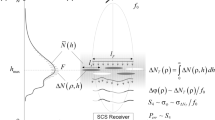Abstract
Besides their intended use in radio navigation, global positioning system (GPS) satellite signals provide convenient radio beacons for ionospheric studies. Among other propagation phenomena, the ionosphere affects GPS signal propagation through amplitude scintillations that develop after radio waves propagation through ionospheric electron density irregularities. This paper outlines the design, testing, and results of a specialized GPS receiver to monitorL-band scintillations. The scintillation monitor system consists of a commercial GPS receiver development kit with its software designed to log signal strength and carrier phase from up to 12 channels at one sample per second rate. Other prime features of the monitor include the data compression transmission and processing. Here is the fact that they are inexpensive and compact and therefore can be readily proliferated.
Similar content being viewed by others
References
Basu S, Groves K M, Quinn J M,et al. A Comparison of TEC Fluctuations and Scintillations at Ascension Island.Journal of Atmospheric and Solar-Terrestrial Physics, 1999,61: 1219–1226.
Hegarty C, El-Arini M B, Kim T,et al. Scintillation Modeling for GPS-Wide Area Augmentation System Receivers.Radio Science, 2001,36(5): 1221–1231.
Pi X, Mannucci A J, Lindqwister U J,et al. Monitoring of Global Ionospherie Irregularities Using the Worldwide GPS Network.Geophysical Research Letter, 1997,24(18): 2283–2286.
Kersley L. Phase Scintillations and Irregularities in the Northern Polar Ionosphere.Radio Science, 1995,30(1): 619–629.
Aarons J, Mendillo M, Yantosca R. GPS Phase Fluctuations in the Equatorial Region During Sunspot Minimum.Radio Science, 1997,32(4): 1535–1550.
Bhattacharyya A, Beach T L, Basu S,et al. Nighttime Equatorial Ionosphere: GPS Scintillations and Differential Carrier Phase Fluctuations.Radio Science, 2000,35(1): 209–224.
Aarons J, Mendillo M, Yantosca R. GPS Phase Fluctuations in the Equatorial Region During the MISETA 1994 Campaign.Journal of Geophysical Research, 1996,101(A12): 26851–26862.
Van Dierendonck A J, Klobuchar J, Hua Q. Ionospheric Scintillation Monitoring Using Commercial Single Frequency C/A Code Receivers.Proceedings of ION-GPS-93, 1993. 333–342.
Lynch T J.Data Compression Techniques and Application. Beijing: People' s Post and Telecommunications Publishing House, 1989 (Ch).
Gibson J D, Berger T.Digital Compression for Multimedia Principle and Standards Beijing: Publishing House of Electronics Industry, 2000 (Ch).
Author information
Authors and Affiliations
Corresponding author
Additional information
Foundation item: Supported by the National Natural Science Foundation of China (No. 49984001)
Biography: Shu Di-fei (1973-), male, Master candidate, research direction: studying ionosphere on GPS beacons.
Rights and permissions
About this article
Cite this article
Di-fei, S., Ji-sheng, X. Development of an ionospheric scintillation monitor using single frequency GPS receiver. Wuhan Univ. J. Nat. Sci. 7, 189–194 (2002). https://doi.org/10.1007/BF02830312
Received:
Issue Date:
DOI: https://doi.org/10.1007/BF02830312




